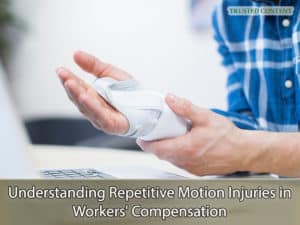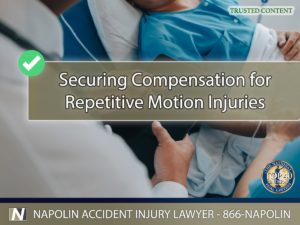Securing Compensation for Repetitive Motion Injuries in California
In the bustling work environments of California, repetitive motion injuries (RMIs) emerge as a prevalent issue, affecting countless workers across various sectors. These conditions, developing silently over time, can significantly hinder an individual's ability to perform their duties and impact their quality of life. This article aims to shed light on RMIs, emphasizing the importance of recognizing symptoms early, understanding workers' rights under California law, and the crucial steps to secure compensation. With the right knowledge and legal assistance, workers can navigate the complexities of workers' compensation claims to protect their health and livelihood.

Understanding Repetitive Motion Injuries in Workers' Compensation
Understanding Repetitive Motion Injuries in Workers' Compensation
Repetitive motion injuries, encompassing a wide range of conditions, are caused by the continuous performance of repetitive tasks, forceful exertions, vibrations, mechanical compression, or sustained or awkward positions. Unlike injuries resulting from a single incident, RMIs develop over time, making them more challenging to diagnose and treat. These injuries not only cause pain and discomfort but can also lead to significant disability, affecting an individual's ability to work and perform daily activities. Recognizing the early signs of RMIs, such as persistent pain, tingling, numbness, or reduced range of motion, is essential for early intervention and preventing long-term damage.
Tendonitis
Tendonitis is an inflammation of the tendons, the thick cords that attach muscles to bones, which can cause pain and tenderness outside a joint. While it can occur in any of the body's tendons, it's most commonly found in the shoulders, elbows, wrists, and heels. This condition is often the result of repetitive motion, overuse, or aging, making certain professions particularly susceptible.
Bursitis
Bursitis results from the inflammation of the bursae, small fluid-filled sacs that reduce friction between moving parts in the body's joints. Repetitive motions or positions that put pressure on the bursae around a joint can lead to this painful condition, emphasizing the need for ergonomic work environments and practices.
Carpal Tunnel Syndrome
Carpal Tunnel Syndrome (CTS) is a condition that arises from pressure on the median nerve as it travels through the wrist at the carpal tunnel. Symptoms include numbness, tingling, and weakness in the hand, often exacerbated by repetitive motions like typing or any activity that involves prolonged wrist flexion or extension.
Trigger Finger/Thumb
Trigger finger or thumb involves the inflammation of the tendons that bend the fingers, causing them to “lock” in a bent position before snapping straight. This condition can be particularly debilitating for workers whose tasks involve gripping or repetitive hand movements.
Back Strains/Sprains
Back strains and sprains are common injuries among workers, resulting from overexertion or repetitive motion involving lifting, bending, or twisting. These conditions highlight the importance of proper lifting techniques and ergonomic workplace adjustments to prevent injury.
Tennis Elbow
Tennis elbow, or lateral epicondylitis, is an overuse injury of the forearm muscles that attach to the outside of the elbow. It's commonly seen in individuals who perform repetitive gripping activities, underscoring the need for equipment and practices that reduce strain on the muscles and tendons.
Rotator Cuff Syndrome
Rotator cuff syndrome encompasses a range of issues, including tendinitis, bursitis, and tears in the rotator cuff – the group of muscles and tendons that stabilize the shoulder. This condition can result from repetitive overhead activities, highlighting the need for workplace modifications and proper rest.
Raynaud's Disease
Raynaud's disease causes some areas of the body, such as the fingers and toes, to feel numb and cold in response to cold temperatures or stress. Workers exposed to vibratory tools or who work in cold environments may be particularly at risk.
Osgood-Schlatter Disease
Osgood-Schlatter disease causes pain and swelling just below the knee due to stress on the patellar tendon. While more common in adolescents, it can also affect adults who engage in activities that involve repetitive knee bending.
California Workers’ Compensation for RMIs
California's workers' compensation system provides a safety net for employees who suffer from work-related injuries, including RMIs. Understanding the nuances of this system is crucial for injured workers seeking compensation. The state mandates that employers provide workers' compensation benefits, which can cover medical expenses, lost wages, and rehabilitation costs. However, the burden of proof lies with the employee to demonstrate that the injury is work-related, a task that can be daunting without proper guidance.

Proving Your Repetitive Motion Injury Claim
Proving Your Repetitive Motion Injury Claim
Successfully proving an RMI claim requires a comprehensive approach, including detailed documentation of work activities, medical records linking the injury to those activities, and timely reporting of symptoms to employers. Engaging with healthcare providers who understand the complexities of RMIs is also critical, as their evaluations and testimony can be pivotal in substantiating a claim.
Legal Representation for RMI Claims
Navigating the workers' compensation claims process can be overwhelming, particularly for workers suffering from RMIs. Securing experienced legal representation can make a significant difference in the outcome of a claim. A knowledgeable attorney can provide strategic advice, manage the collection of evidence, and advocate on behalf of the injured worker, ensuring that their rights are protected and that they receive the full benefits to which they are entitled.
Preventing Repetitive Motion Injuries
Prevention is key to addressing the issue of RMIs in the workplace. Employers and employees must collaborate to create ergonomic workspaces, implement regular breaks, and foster a culture of safety. Training on proper body mechanics and the use of assistive devices can also reduce the risk of injury, promoting a healthier, more productive workforce.

Securing Compensation for Repetitive Motion Injuries in California
Securing Compensation for Repetitive Motion Injuries in California
Repetitive motion injuries pose a significant challenge to workers throughout California, but understanding one's rights and the available avenues for compensation can empower affected individuals. If you are experiencing symptoms of an RMI, it's crucial to seek medical attention, report the injury to your employer, and consider consulting with a legal professional. At Napolin Accident Injury Lawyer, we are committed to supporting injured workers. Call us at (866)-NAPOLIN for a free consultation, and let our extensive experience in workers' compensation claims work for you. Together, we can navigate the path to recovery and secure the compensation you deserve.
- Understanding Uber Accidents and Insurance Coverage Periods in California - April 8, 2025
- A Guide on Red Light Auto Accidents in California - August 14, 2024
- Self-Representing in a California Personal Injury Claim - August 13, 2024
